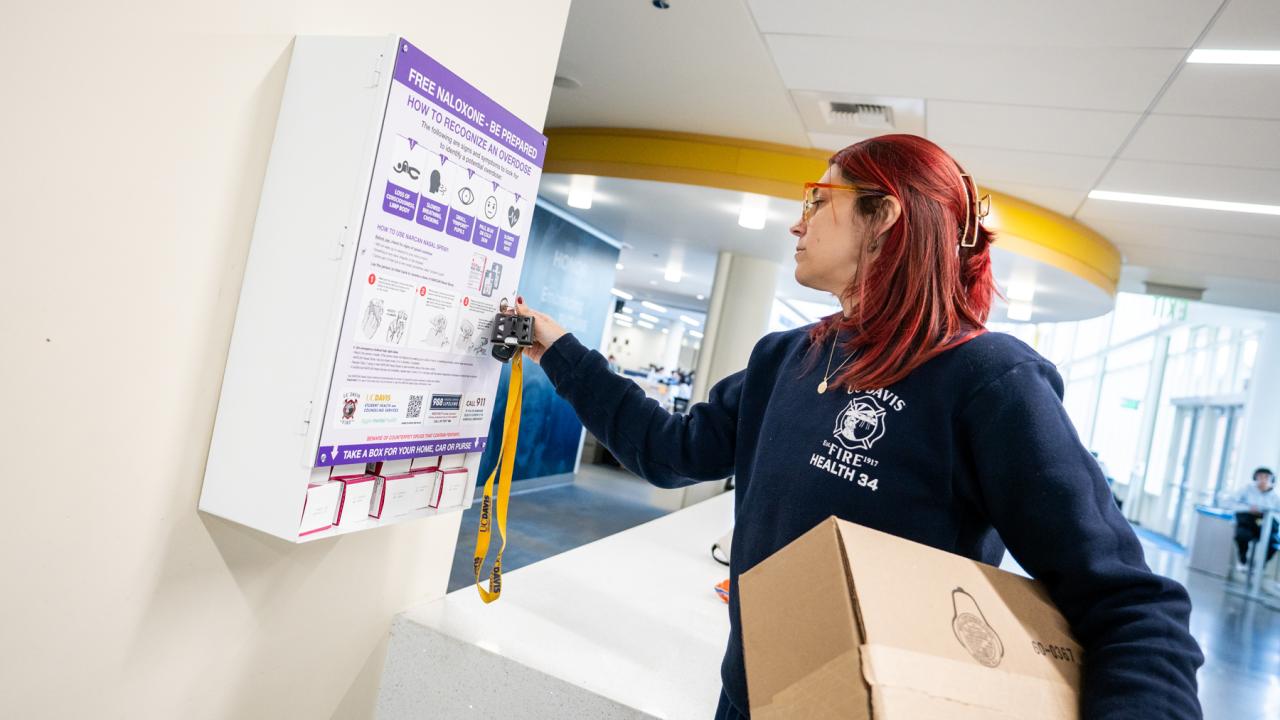
UC Davis Fire Helps Make Lifesaving Overdose Meds More Available
From Narcan to AEDs, Building a Campus Culture of Crisis Response
The UC Davis Fire Department made a life-saving opioid antidote more widely available this year — dramatically increasing the doses of naloxone (also known as Narcan) distributed on the UC Davis campus.
What made the difference? Four new, self-service cabinets in high-traffic campus locations make it possible to pick up a free box of naloxone nasal spray more easily, anonymously and around-the-clock. More than 1,800 boxes of naloxone were picked up from these cabinets in six months.
Widespread availability of naloxone has been cited as a critical factor in the recent national downward trend in deaths from opioid overdoses, including fentanyl.
“These free Narcan lockers are for everyone, not just students,” said Chelsea Kahn, an EMT who works with the UC Davis Fire Department’s Health 34 team. “We’re seeing there’s a desire to have these life-saving medications easily accessible — especially from these anonymous locations where you don’t have to talk to someone or write your name down. I hope our efforts continue to prevent deaths.”
New public locations with extended hours
The four new cabinets include educational materials, in public locations on campus with extended hours:
- Memorial Union: Inside the east entrance, next to the information desk.
- Shields Library: In the 24-hour study room.
- Student Community Center: Inside the north entrance.
- Activities and Recreation Center: In the ARC study lounge.
The cabinets in the MU and Student Community Center are each next to one of 100+ automatic external defibrillators, or AEDs, that are publicly accessible on campus for emergency use.
The UC Davis Fire Department coordinated the establishment of the new cabinets with Facilities Management, with support from Healthy UC Davis and Equity in Mental Health funds via Student Affairs. The Fire Department also partners with the Health Education and Promotion team in Student Health and Counseling Services to coordinate naloxone distribution sites and education. The boxes of naloxone are provided free to UC Davis from the California Department of Healthcare Services.

Preparing to respond in moments of need
To keep the cabinets well stocked, student staff members with the Fire Department’s Health 34 program check the cabinets regularly. In the first six months of the new cabinets, more than 1,800 boxes of naloxone (each with two doses) were distributed through them. The Health 34 team also brings naloxone with them on calls and can leave doses with community members, though Kahn explained they have only rarely encountered applicable situations.
The Fire Department also partnered with ASUCD and the Health Education Program in spring 2024 to host a “Nalox-Zone” event promoted as preparation for “houseboats and festival season” that included naloxone education, distribution, free T-shirts and live DJ music. Naloxone information is also part of the Fire Department’s CPR and First Aid classes, which are available to UC Davis students for free
“We’re helping build a culture of responding to emergencies,” said Dr. Lisa Mills, medical director for UC Davis Fire Department and also an emergency medical physician with UC Davis Health. “In communities where this culture of responding has already been embedded, their survival rates are astronomical in comparison to the rest of us. So we are creating a culture where people understand that being part of society also means responding in these moments of need.”
How to spot an overdose and how you can help
“This is what anyone can do to help fight the opioid crisis,” Kahn said.
“Knowing how to recognize what is going on, what steps to take, and having the naloxone spray handy can potentially save someone’s life.”
Kahn explained that naloxone does not cause harm if it is given to someone who is not overdosing on an opioid. A UC Davis Health video also shows how to use Narcan.
Signs:
- Lethargy: The person is very lethargic, almost very sleepy, and you can’t quite wake them up.
- Slow breathing: They’re breathing very slowly or shallowly. You have to focus to notice breathing.
- Pinpoint pupils: If you open their eyelids and look at their pupils, they're teeny, tiny, pinpoints.
“If these signs come together, you should think: Opioid overdose,” Kahn said.
Steps for you to take:
- First call 911. Even if the naloxone works, the person may need to go to the hospital.
- Administer the naloxone. Follow package directions to put it in their nose and spray. Then take a couple steps back. It’s best to wait a couple feet away, as the person can revive suddenly with potential for vomiting or aggressiveness.
- Follow directions from the 911 dispatcher. They're trained to help in medical emergencies and will direct you in ways you can help if you feel comfortable, from rolling the person on their side to potentially performing CPR.
- Make sure to stay until first responders arrive. Information you provide to first responders can also be critical in caring for the patient.
See the UC Davis Narcan map for where to find free naloxone on the Davis campus, including locations with a nurse or attendant to help.
